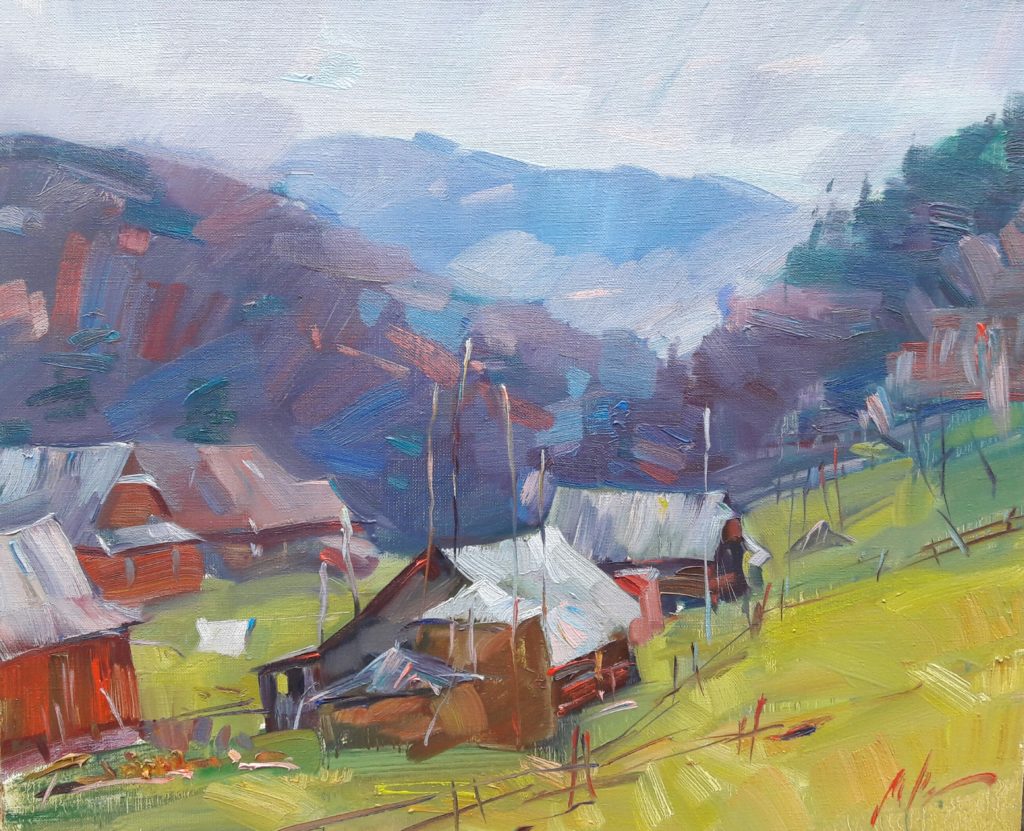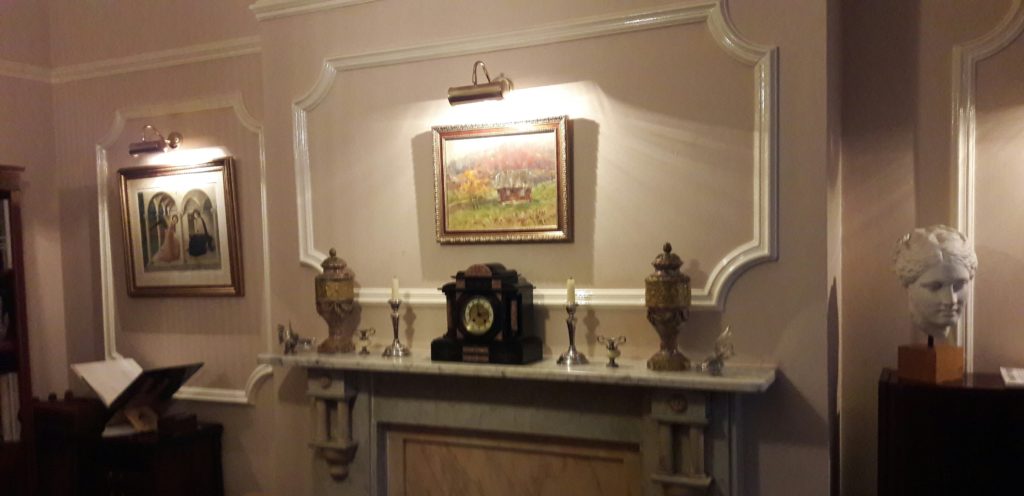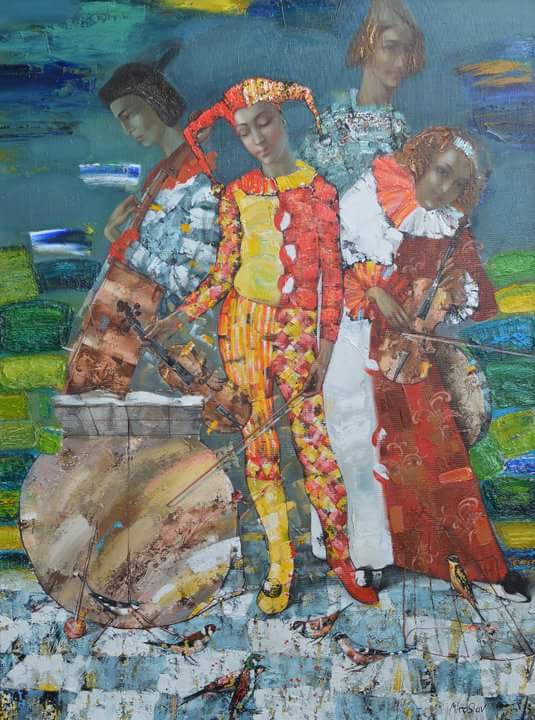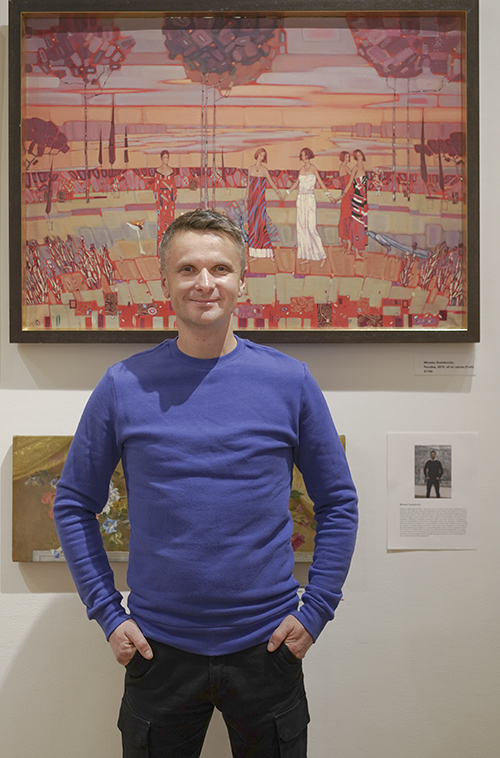Ulya Aligulova, interview with Miroslav Duzinkevich
I met Miroslav at a group exhibition in downtown New York where he was exhibiting five of his works. Walking around the gallery for the first time, I didn’t realise that the 5 pieces of art that were so strikingly different from one another belonged to the same artist. My eye was caught by a large canvas in red hues depicting three women in a garden. The highly decorative elements of their dresses and the flora of the garden executed in the Art Nouveau style bore a strong resemblance to the works of Gustav Klimt. Below it three Baroque style floral still lifes stylistically so complex that they seemed to have time travelled from the 17th century. The ensemble was complete with a large scale canvas of a bright yellow cat that looked like it was painted by a child. Never before have I met an artist so incredibly stylistically diverse.
What was it that first inspired you to become an artist?
Since early childhood I’ve always been drawn to beauty: to beautiful things, beautiful people. Refinement is very important to me in everything: in artwork, in people, in things. But in early childhood you don’t think about these things, you simply like pretty things.
It all happened very unexpectedly. My mother introduced me to the local painter when I was 12-13 and I studied under him for 2 years. After that, in a natural progression, I moved from my little hometown to Kiev, which was a little scary, to study at the National Art School. It was one of only 3 specialised art schools in all of the USSR. There was a major competition that determined the 3 students that would have the opportunity to attend the school that year. I was lucky to be one of them.
How did your career as an artist first begin?
I guess it started with the art school. We would go out for plein air painting and then sell our works. But it really took off after I was accepted to the National Academy of Fine Arts and Architecture. From my first year there when I started painting more professionally my sales grew exponentially. I started getting many commissions, I painted many portraits. And in third year myself and other students started actively participating in various national art exhibitions. Essentially, the technical education was only until the 3rd year and after that it was mostly exhibition work.
Tell me more about your time at the academy and the type of artistic education you received there.
At the academy, there was a big focus on academicism and classical art. In third year we could choose a genre to specialise in and I chose history painting. I learned everything about painting the human body, proportions, and portraiture. I loved figurative art in general and it was important for me to learn all of these classical techniques because, in my opinion, to be able to paint people well enough to convey their inner soul, you need to have a strong academic education.
Art is all about color. Everyone has a color associated with them: some are warm toned and some are cool toned. Likewise, every person has their own vision of color. But regardless of any artist’s vision, a painting, at the end of the day, is somewhat of a science with its own laws and regulations. And to be able to paint figuratively you need to know and follow these rules of proportions, color theory, composition, etc. 
Graduation work is normally the most important assignment in an Art Academy. What was yours like? Anything special you can share about your graduation?
My work was on the Biblical theme of Jesus before Pontius Pilate. It was a large scale work with dimensions of 3 metres by 1.2 metres which took me 3 months to complete. I tried to demonstrate all the techniques I learned at the academy. At the end of my graduation ceremony, the provost of the academy announced that the best graduation work, as chosen by the ministry of culture, in the whole year was my piece. That instant I will never forget. It was a moment of pure happiness that is only comparable to feelings you experience during the birth of your child. Though an artist can never be 100% satisfied with his work, at that moment I felt immense pride. And on that high note I felt that a chapter of my life was coming to a close.
After my bachelors degree at the academy, I was one of the 3-4 people in my year to be invited to continue my education at graduate school. In graduate school I moved away from the strictly classical approaches we were taught in earlier years and started exploring modern art a lot more.
You’ve also taught fine art at the same Academy later on. What was your teacher experience like?
I really enjoyed that job. I had gained a lot of knowledge during my studies and I loved passing it onto my students. But it was also exhausting at times. Trying to explain something to a student that they don’t understand is frustrating and takes a lot of energy as you try different approaches to teach them. If you’re painting a picture you need to really invest yourself and experience it and the same goes for teaching. Students are different. Someone understands what you’re saying from the first time, someone from the 5th time and someone never does because they’ll never need it in life. In fact, most fine arts graduates don’t end up becoming artists. But the most important thing, in my opinion, is that the student is left with a sense of taste, a sense of the beautiful because it will help them in other types of work. Steve Jobs, for instance, studied calligraphy and it helped him in designing. It was his artistic eye and a sense of excellence that he translated into tech design. For me it was crucial to convey this sense of artistic taste and aesthetics to my students. Although I didn’t teach for long as I wanted to work for myself as an artist, I remained friends with many of my students for many years. Few of them stayed in fine arts and most left to do some sort of design:interior design, tech design.
At this exhibition you’ve clearly demonstrated that you don’t stick to just one style. What other styles do you work in?
My favorite is the combination of realism with stylised abstraction and decorative art. In university I only ever painted with oil but now I’m really drawn to acrylic paint. It dries faster but lacks the depth of color of oil. Acrylic paint gives a splash of emotion because you can paint your feelings quickly. What I like most about it though is its texture. Art is inextricably linked with interior design. Especially nowadays with innovative interior like lofts, textured art is more advantageous. The combination of concrete, wood, white walls and textured paintings looks very dramatic. With acrylic paint I felt more liberated in my work because it allowed me to relax and play around. It was especially useful when I attended plein airs in Europe having to do sketches and etudes in 2-3 hours only. It was a new experience because while at the academy I was used to working on a painting for half a year carefully drawing each line, at these plein airs I only had a couple hours.
So today I’d say I mostly work in 3 styles. I still love very detailed classical works like still lifes and portraits but on the other hand I also enjoy the combination of realism with an abstract background or expressionism. With my etudes I don’t think too much and sketch for only 15-30 minutes, sometimes with nothing but a palette knife, just to convey an emotion quickly. But even in that case, I think you need a strong academic background, because depicting a landscape in such a short time requires technical knowledge of light, proportions, color and more.
What artists do you always turn to for inspiration? Who do you look up to more?
I consider Velazquez my mentor. No other artist impresses me as much as he does. His style of painting is almost impressionist-like. Whereas Dutch artists of the time used undercoats and glaze, and generally very lengthy processes to work on their paintings, I realized, upon my careful examination of Velazquez’s work, that he did everything alla prima. You can see that because his paintings lack very clearly drawn out details common for paintings of that era. In my personal opinion, Velazquez marked the very beginning of impressionism. I also adore Vermeer. Though his works are small scale, there’s so much refinement in them. For me that refinement is the peak of artistry.
But those are classical artists. When it comes to modern art, its objective is very different. I always argue with my friends and artists if modern art is supposed to be pleasant to look at. Take the contemporary artist Gerhard Richter, for example. He’s arguably the most sellable artist right now, his works are sold for 30 million, yet most people think his works look like plaster you use on buildings. Same goes for Malevich. Everyone likes to say they can also paint a black square. But that work is a world renowned masterpiece and regardless of what anyone says, it is a unique concept, Malevich’s manifesto, his vision, his world.
You mentioned before that you participated in competitions, can you tell me more about them?
There were many competitions I won during my university years. I remember in my first year we were assigned to produce 7 paintings. 6 of them were taken to be kept at the academy’s art fund. Same goes for my graduate work. I also won several citywide and nationwide competitions. But I also got to be on the other side of the table as a jury. It was a confusing emotion at first because, as a competitor, I often felt my work wasn’t being judged rightfully, so when I was a jury I worried about someone feeling like that about my judgement. But I learned soon to be coldblooded and judge strictly whether the work had any artistic value or not. After university when I actively started travelling for international plein airs, I took part in international competitions as well.
You’ve been around Europe quite a lot. In which countries did you exhibit your works?
I had solo exhibitions in Genoa Italy in 2011, in Bulgaria, Bratislava, Istanbul, Poland. My works were also part of group exhibitions in Germany, Spain and London. 
Why did you decide to move to the United States?
I’ve been in Europe a lot so I wanted to explore new territory. When I visited for the first time for my exhibition at the International Art Festival, I realised that life here is much more interesting than anywhere else. That’s when I met Tatyana who curated my second group exhibition in New York. When I visited for the third time I knew for sure that I need to move to New York because I want to be in this environment of painters, people in arts, people who appreciate art. This is where all the opportunities are. I’m in New York for only a month and I’m going to be exhibited for the third time here, this time a solo exhibit in March. Additionally, in one of those exhibitions, I was also part of the jury. I’ve also entered my works to the competition New York Realism and online auctions.
Everything moves faster here, the rhythm of life is intense than in Europe but it is also freeing. Everyone paints the way they want. There’s no emphasis on the school of classical art like back home. There’s lightness here, diversity, people don’t bother so much with the academic techniques. You can’t afford to spend 3 months on a painting. Life has moved on, everything is done quickly. But in that haste you still need to convey whatever you conveyed in 3 months before. Any kind of work, any kind of style or direction can find its niche and its appreciator in New York. If you have an idea, people realize it. Society is focused on success. I want to be part of that.







